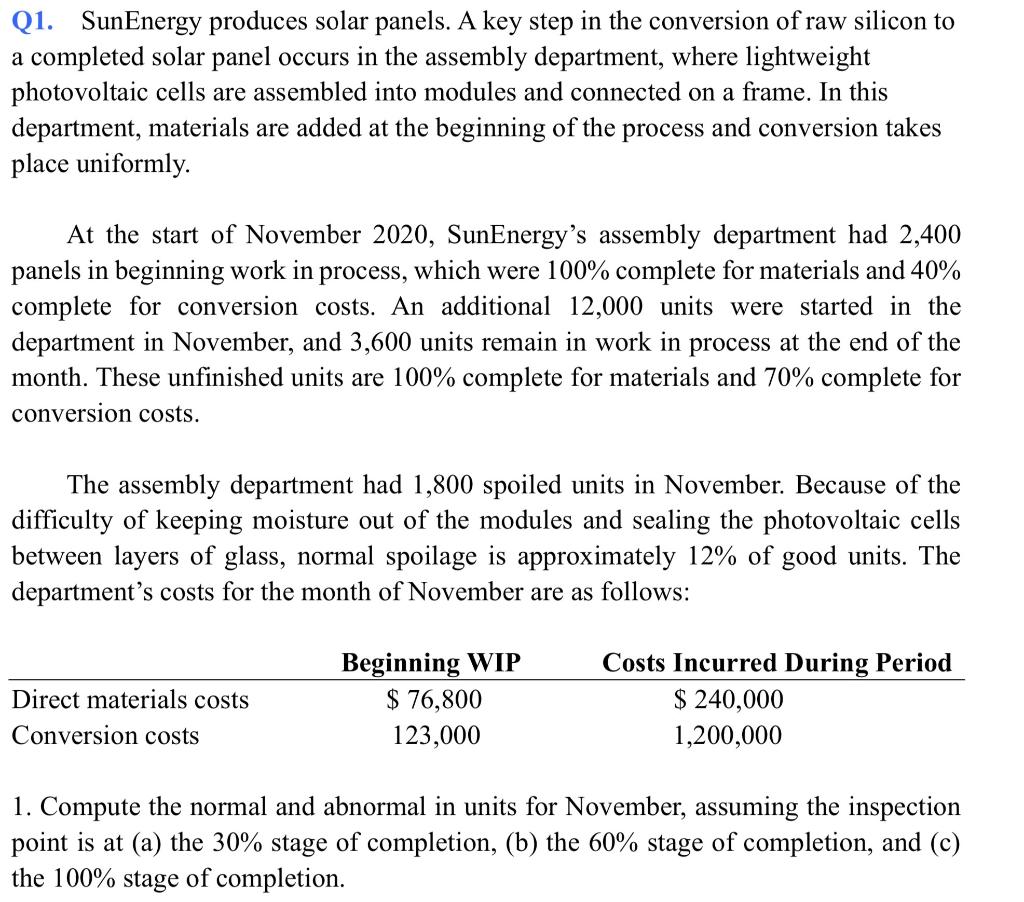

Q1. SunEnergy produces solar panels. A key step in the conversion of raw silicon to a completed solar panel occurs in the assembly department, where lightweight photovoltaic cells are assembled into modules and connected on a frame. In this department, materials are added at the beginning of the process and conversion takes place uniformly. At the start of November 2020, SunEnergy's assembly department had 2,400 panels in beginning work in process, which were 100% complete for materials and 40% complete for conversion costs. An additional 12,000 units were started in the department in November, and 3,600 units remain in work in process at the end of the month. These unfinished units are 100% complete for materials and 70% complete for conversion costs. The assembly department had 1,800 spoiled units in November. Because of the difficulty of keeping moisture out of the modules and sealing the photovoltaic cells between layers of glass, normal spoilage is approximately 12% of good units. The department's costs for the month of November are as follows: 1. Compute the normal and abnormal in units for November, assuming the inspection point is at (a) the 30% stage of completion, (b) the 60% stage of completion, and (c) the 100% stage of completion. 2. Refer to your answer in requirement 1 . Why are there different amounts of normal and abnormal spoilage at different inspection points? 3. Now assume that the assembly department inspects at the 60% stage of completion. Using the weighted-average method, calculate the cost of units transferred out, the cost of abnormal spoilage, and the cost of ending inventory for the assembly department in November. Q1. SunEnergy produces solar panels. A key step in the conversion of raw silicon to a completed solar panel occurs in the assembly department, where lightweight photovoltaic cells are assembled into modules and connected on a frame. In this department, materials are added at the beginning of the process and conversion takes place uniformly. At the start of November 2020, SunEnergy's assembly department had 2,400 panels in beginning work in process, which were 100% complete for materials and 40% complete for conversion costs. An additional 12,000 units were started in the department in November, and 3,600 units remain in work in process at the end of the month. These unfinished units are 100% complete for materials and 70% complete for conversion costs. The assembly department had 1,800 spoiled units in November. Because of the difficulty of keeping moisture out of the modules and sealing the photovoltaic cells between layers of glass, normal spoilage is approximately 12% of good units. The department's costs for the month of November are as follows: 1. Compute the normal and abnormal in units for November, assuming the inspection point is at (a) the 30% stage of completion, (b) the 60% stage of completion, and (c) the 100% stage of completion. 2. Refer to your answer in requirement 1 . Why are there different amounts of normal and abnormal spoilage at different inspection points? 3. Now assume that the assembly department inspects at the 60% stage of completion. Using the weighted-average method, calculate the cost of units transferred out, the cost of abnormal spoilage, and the cost of ending inventory for the assembly department in November








